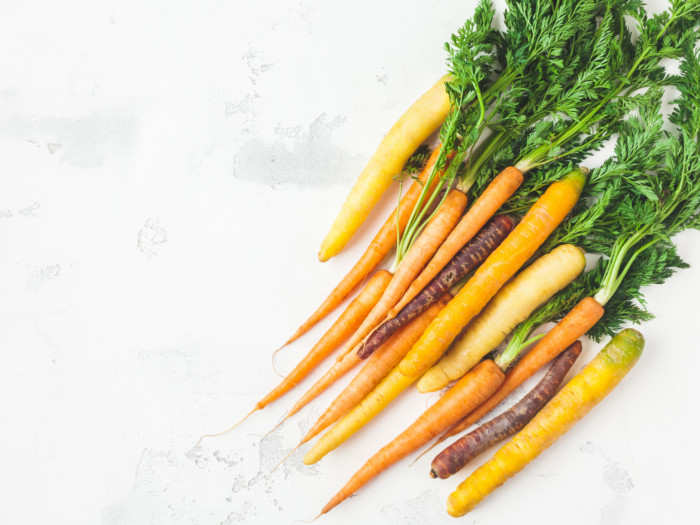For those who want to try different types of carrots, there are plenty of options to choose from, and while many of them share flavor and nutrient characteristics, there are some important differences that you should know!
Different Types of Carrots
The most popular and readily available types of carrots include Chantenay carrots, Danvers carrots, baby carrots, Imperator carrots, and Nantes carrots, to name a few. Each of these larger groups also contains subtypes that vary slightly, but those minute details are beyond the scope of this article. [1]
Chantenay Carrots
These carrot varieties grow to about 6-7 inches in length, known for having broad “shoulders”, tapering to a stocky tip. These carrots are also known to be quite hardy and can grow in more difficult conditions. The carrot greens in this variety will grow very aggressively, which may lead people to leave the carrots in the ground for too long. If they are not harvested at the proper time, however, they can become woody and unpleasant to eat. That being said, these carrots are also known to store very well over the course of the winter. [2]

The many hues of carrots make a colorful platter of roasted vegetables. Photo Credit: Shutterstock
Danvers Carrots
This is the classic image of a carrot that most people imagine, ranging from 7-9 inches in length tapering evenly from the carrot green stem down to the tip. Famed for growing in rocky or harsher soils, this is a very popular cultivar in areas where cultivation is more difficult. Orange is the most common color for these carrots, which were first cultivated in Danvers, Massachusetts, but other shades are also available. They are often blocky or conical in shape, giving them a sturdier appearance. [3]
Imperator Carrots
If you buy carrots in the grocery store or in commercial markets, these are most likely the carrots you buy. Roughly 10-12 inches in length, these are long and slender, but also hearty and strong, with a sweet core and a pleasant flavor. Imperator carrots only come in two varieties – Autumn King and Atomic Red – but there is a good chance that you have eaten both of them many times in your life! These can be stored for a week outside the fridge but should be refrigerated or frozen if you plan to keep them for longer. These need to be grown in very fine soil that penetrates at least one foot down. [4]
Nantes Carrots
This variety of carrot doesn’t always look like a carrot, as they can be quite short and stocky, with very little green foliage at the top. The flesh is nearly red and the carrots have a very satisfying crunch, as well as a subtle sweetness. Popularly grown in many regions of France, there are more than 40 subtypes of Nantes carrots, and they are most commonly consumed in Europe, although they are available in the US and UK. [5]
Planet Carrots
One of the most unusual types of carrot, planet carrots develops a taproot that is roughly the size of a golf ball. There is less sweetness in this variety than in the others, and the taproot can extend slightly longer or form an oval shape, but these generally remain quite small. These carrots were specifically developed to flourish in heavy, clay soils where other types of carrots would fail.
Baby Carrots
Although many people think these are stunted carrots, they are actually carved out of underdeveloped or broken carrots, before the woodiness and core of the carrot begin to form. Baby carrots were once made from any type of carrot, as a means to get the most out of the harvest, but now the larger carrots that lead to baby carrots are specially bred. Famers now grow baby carrots to be slightly sweeter than other varieties, making them the perfect snack food! [6]
So go ahead and fill you vegetable basket with different colors!
